Wikipedia
This text was copied from Wikipedia on 14 January 2025 at 6:10AM.
| Lord Mayor of London | |
|---|---|
 | |
since 8 November 2024 | |
| Style | My Lord Mayor The Right Honourable |
| Residence | Mansion House, EC4 |
| Appointer | Electors: Aldermen |
| Term length | One year |
| Inaugural holder | Sir Henry FitzAlan |
| Formation | 1189 |
| Salary | None (pro bono) |
| Website | Official website |
The Lord Mayor of London is the mayor of the City of London, England, and the leader of the City of London Corporation. Within the City, the Lord Mayor is accorded precedence over all individuals except the sovereign[1] and retains various traditional powers, rights, and privileges, including the title and style The Right Honourable Lord Mayor of London.
One of the world's oldest continuously elected civic offices, it is entirely separate from the directly elected mayor of London, a political office controlling a budget which covers the much larger area of Greater London.
The Corporation of London changed its name to the City of London Corporation in 2006, and accordingly the title Lord Mayor of the City of London was introduced, so as to avoid confusion with that of Mayor of London. The legal and commonly used title remains Lord Mayor of London. The Lord mayor is elected at Common Hall each year on Michaelmas, and takes office on the Friday before the second Saturday in November, at The Silent Ceremony. The Lord Mayor's Show is held on the day after taking office; the Lord Mayor, preceded by a procession, travels to the Royal Courts of Justice at the Strand to swear allegiance to the sovereign before the Justices of the High Court.
The Lord Mayor's main role nowadays is to represent, support and promote the businesses and residents in the City of London. Today these businesses are mostly in the financial sector, and the Lord Mayor is regarded as the champion of the entire UK-based financial sector regardless of ownership or location throughout the country. As leader of the Corporation of the City of London, the Lord Mayor serves as the key spokesman for the local authority and also has important ceremonial and social responsibilities. The Lord Mayor is non-affiliated politically, typically delivering many hundreds of speeches and addresses per year and attending many receptions and other events in London and beyond. Incumbents usually make overseas visits under the auspices of the FCDO.[2] The Lord Mayor, ex officio Rector of City, University of London and also Admiral of the Port of London, is assisted in day-to-day administration by the Mansion House 'Esquires' whose titles include the City Marshal, Sword Bearer and Common Crier.
Alastair King serves as the 696th Lord Mayor (for 2024–2025). The Lord Mayor is also assisted by The Venerable Ray Pentland CB QHC as Lord Mayor's Chaplain. The Lord Mayor’s office is also served by Aide de Camp representing the Uniformed Youth Organisations and they will be pleased to assist in the arranging of new affiliations. The Lord Mayor has six individual Cadet ADCs representing the various Uniformed Youth Organisation branches who provide him with a connection to the City Cadet Forces.[3] [4]
Titles and honours
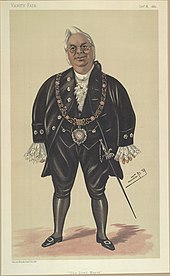
Of the 69 cities in the United Kingdom, the City of London is among the 30 that have lord mayors (or, in Scotland, lords provost). The Lord Mayor is entitled to the prefix The Right Honourable; the same privilege extends only to the lord mayors of York, Cardiff, Bristol and Belfast, and to the lords provost of Edinburgh and Glasgow. The style is used when referring to the office as opposed to the holder thereof; thus, "The Rt Hon Lord Mayor of London" would be correct, while "The Rt Hon William Russell" would be incorrect. The latter prefix applies only to privy counsellors and peers.
A woman who holds the office is also known as a Lord Mayor. The wife of a male Lord Mayor is styled as Lady Mayoress, but no equivalent title exists for the husband of a female Lord Mayor. A female lord mayor or an unmarried male lord mayor may appoint a female consort, usually a fellow member of the corporation, to the role of lady mayoress. In speech, a lord mayor is referred to as "My Lord Mayor", and a lady mayoress as "My Lady Mayoress".
It was once customary for lord mayors to be appointed knights upon taking office and baronets upon retirement, unless they already held such a title. This custom was followed with a few inconsistencies from the 16th until the 19th centuries; creations became more regular from 1889 onward. From 1964 onward, the regular creation of hereditary titles such as baronetcies was phased out, so subsequent lord mayors were offered knighthoods (and, until 1993, most often as Knight Grand Cross of the Order of the British Empire (GBE)). Since 1993, lord mayors have not automatically received any national honour upon appointment; instead, they have been made knights bachelor upon retirement, although Gordon Brown's Government broke with that tradition by making Ian Luder a CBE, after his term of office in 2009, and the following year Nick Anstee declined offers of an honour. Furthermore, foreign heads of state visiting the City of London on a UK state visit, diplomatically bestow upon the Lord Mayor one of their suitable national honours. For example, in 2001, Sir David Howard was created a grand cordon (first class) of the Order of Independence of Jordan by King Abdullah II. Recently lord mayors have been appointed at the beginning of their term of office knights or dames of St John, as a mark of respect, by the late Queen Elizabeth II, Sovereign Head of the Order of St John until her death in 2022.
History
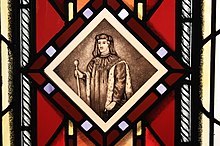
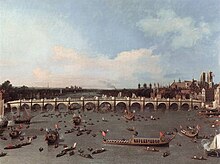

The office of mayor was instituted in 1189, the first holder of the office being Henry Fitz-Ailwin de Londonestone. The mayor of the City of London has been elected by the City, rather than appointed by the sovereign, ever since a royal charter providing for a mayor was issued by King John in 1215. The title "lord mayor" came to be used after 1354, when it was granted to Thomas Legge (then serving his second of two terms) by King Edward III.
Lord mayors are elected for one-year terms; by custom, they do not now normally serve more than one consecutive term. Numerous individuals have served multiple terms in office, including:
As mayor
- 24 terms: Sir Henry FitzAlan (1189–1212)
- 9 terms: Ralph de Sandwich (1285–1289, 1289–1292)
- 8 terms: Gregory de Rokesley (1274–1280, 1284)
- 7 terms: Andrew Buckerel (1231–1237); John le Breton (1289, 1293–1298); John le Blund (1301–1307)
- 6 terms: Richard le Ranger (1222–1226, 1238); Hamo de Chigwell (1319, 1321, 1322, 1324, 1325, 1327)
- 5 terms: Serlo le Mercer (1214, 1218–1221)
As Lord Mayor
- Sir Nicholas Brembre (1377, 1383–1385; 4 terms)
- Sir Richard ('Dick') Whittington (1397, 1398, 1406 and 1419; 4 terms)
- William Sevenoke (1418)
- Sir Robert Fowler (elected in 1883 and in 1885).[5]
- Sir William Russell (2019–2021, 2 terms)
Almost 700 people have served as lord mayor. Dame Mary Donaldson, elected in 1983, as well as Dame Fiona Woolf, elected in 2013, are the only women to have held the office.
Some lord mayors in the Middle Ages, such as Sir Edward Dalyngrigge (1392), did not reside in London. Since 1435, the lord mayor has been chosen from amongst the aldermen of the City of London.
Election
The lord mayor is elected at Common Hall, comprising liverymen belonging to all of the City's livery companies. Common Hall is summoned by the sitting lord mayor; it meets at Guildhall on Michaelmas Day (29 September) or on the closest weekday. Voting is by show of hands; if any liveryman so demands, balloting is held a fortnight later.
The qualification to stand for election is that one must have served as a City sheriff and be a current alderman. Since 1385, prior service as sheriff has been mandatory for election to the lord mayoralty. Two sheriffs are selected annually by Common Hall, which meets on Midsummer's Day for this purpose. By an ordinance of 1435, the lord mayor must be chosen from amongst the aldermen of the City of London. Those on the electoral roll of each of the City's 25 wards select one alderman, who formerly held office for life or until resignation. Now each alderman must submit for re-election at least once in every six years.
The lord mayor is then sworn in November, on the day before the Lord Mayor's Show (see below). The ceremony is known as the "Silent Ceremony" because, aside from a short declaration by the incoming Lord Mayor, no speeches are made. At Guildhall, the outgoing lord mayor transfers the mayoral insignia – the seal, the purse, the sword and the mace — to the incoming lord mayor.
The lord mayor to be elected in November 2017 was known in April of that year.[6]
Show
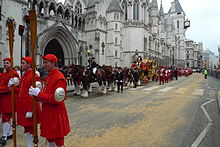
The day after being sworn into office, the lord mayor leads a procession from the City of London to the Royal Courts of Justice in the City of Westminster, where the lord mayor swears allegiance to the Crown. This pageantry has evolved into one of London's longest-running and most popular annual events, known as the "Lord Mayor's Show". The lord mayor travels in the City's state coach that was built in 1757 at a cost of £1,065.0s.3d. Nowadays, this festival combines traditional British pageantry with the element of carnival,[7] and since 1959 it has been held on the second Saturday in November. Participants include the livery companies, bands and members of the military, charities and schools. In the evening, a fireworks display is held.
Role
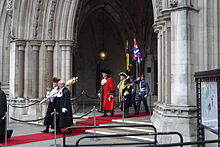
The lord mayor is a member of the City of London's governing body, the City of London Corporation (incorporated as The Mayor and Commonalty and Citizens of the City of London). The Corporation comprises the Court of Aldermen and the Court of Common Council; the former includes only the aldermen, while the latter includes both aldermen and common councilmen. The Lord mayor belongs to and presides over both bodies.
As noted earlier, the main role of the lord mayor is to represent, support and promote all aspects of UK-financial service industries, including maritime. They undertake this as head of the City of London Corporation and, during the year, host visiting foreign government ministers, businessmen and dignitaries; furthermore, they conduct several foreign visits of their own so as to promote British financial sectors.[2]
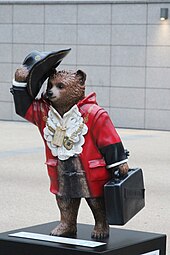
Banquets hosted by the Lord Mayor serve as opportunities for senior government figures to deliver major speeches. At the Lord Mayor's Banquet (held on the Monday after the Lord Mayor's Show), the Prime Minister delivers the keynote address. At the Banker's Dinner in June, the Chancellor of the Exchequer delivers a speech known as the "Mansion House Speech", which takes its name from the Lord Mayor's residence. At the Easter Banquet, also hosted each year at the Mansion House, the Foreign Secretary addresses an audience of international dignitaries.
The lord mayor sometimes takes part in major state occasions; for example, in 2013, the then-lord mayor, Sir Roger Gifford, carried the Mourning Sword at Margaret Thatcher's funeral, processing ahead of the Queen and Prince Philip, Duke of Edinburgh, into St Paul's Cathedral.
The lord mayor performs numerous other functions, including serving as the chief magistrate of the City of London, admiral of the Port of London, rector of City, University of London, president of Gresham College, president of City of London Reserve Forces and Cadets Association, and trustee of St Paul's Cathedral. The lord mayor also heads the City's Commission of Lieutenancy, which represents the sovereign in the City of London (other counties usually have lord lieutenants, as opposed to Commissions), and annually attends the Treloar Trust (named after Sir William Treloar, lord mayor in 1906), in Hampshire. The Treloar Trust runs two educational sites for disabled children, a school and college.[8]
Rights and privileges

The residence of the lord mayor is known as Mansion House. The establishment of the residence was considered after the Great Fire of London (1666), but construction did not commence until 1739. It was first occupied by a lord mayor in 1752, when Sir Crispin Gascoigne took up residence. The official car of the lord mayor is a Rolls-Royce Phantom VI with registration number LM0.
In each of the eighteen courtrooms of the Old Bailey, the centre of the judges' bench is reserved for the lord mayor, in his capacity of chief justice of the City of London. The presiding judge therefore sits to one side.[9]
It is sometimes asserted that the lord mayor may exclude the monarch from the City of London. The legend is based on the misinterpretation of the ceremony observed each time the sovereign enters the City: at Temple Bar the lord mayor presents the City's Pearl Sword to the sovereign as a symbol of the latter's overlordship. The monarch does not, as is often purported, wait for the lord mayor's permission to enter the City. When the sovereign enters the City, a short ceremony usually takes place where the lord mayor presents a sword to the monarch, symbolically surrendering their authority. If the sovereign is attending a service at St Paul's this ceremony would take place there rather than at the boundary of the City for matters of convenience.
The importance of the office is reflected by the composition of the Accession Council, a body which proclaims the accession of new sovereigns. The Council includes the lord mayor and aldermen of London, as well as members of the House of Lords and privy counsellors. At the coronation banquet which followed, the lord mayor of the City of London had the right to assist the royal butler. The same privilege is held by the lord mayor of Oxford; the mayor of Winchester may assist the royal cook. Such privileges have not been exercised since 1821, when the last coronation banquet (celebrating the coronation of George IV) was held.
Official dress
On formal occasions the lord mayor wears traditional black velvet court dress (old style) consisting of a coat, waistcoat and knee breeches with steel cut buttons. This is worn with black silk stockings, patent court shoes with steel buckles, white shirt with lace cuffs and a large jabot stock. This form of court dress is worn by all lord mayors regardless of gender.
When outdoors, they wear a black beaver plush tricorne hat trimmed with black ostrich feathers and a steel 'loop' for the cockade. This has been traditionally made by Patey's commissioned by the Worshipful Company of Feltmakers for each incumbent lord mayor.

Since 1545 the lord mayor of London has worn a Royal Livery Collar of Esses. The collar's origins are not royal, Sir John Alleyn, twice lord mayor, having bequeathed it to the next lord mayor and his successors "to use and occupie yerely at and uppon principall and festivall dayes". It was enlarged in 1567, and in its present shape has 28 Esses (the Lancastrian ‘S’), Tudor roses and the tasselled knots of the Garter (alternating) and also the Portcullis, from which hangs the Mayoral Jewel.[10][11] The collar is worn over whatever the lord mayor may be wearing, secured onto their underdress or State Robes by means of black or white silk satin ribbons on the shoulders.
Robes

As an alderman of the City of London the lord mayor has a scarlet gown and a violet gown, which are identical to those worn by their fellow aldermen except that they are trained. The violet robe is worn at most formal meetings of the Corporation with the scarlet robe substituted on certain days or occasions as directed by the City Ceremonial Book.
For State occasions when the monarch is present, the lord mayor wears a crimson velvet robe of state trimmed with an ermine cape and facings, very similar to a royal earl's coronation robe. It is tied with gold cordons, and dates from the reign of George IV.[11]
On other ceremonial occasions is worn a black silk damask robe trimmed with gold lace of a design exactly the same as that of the Lord Chancellor, known as the Entertaining Gown.[11]
At coronations, the lord mayor wears a special coronation robe: a mantle of scarlet superfine wool trimmed with bars of gold lace and ermine. It is lined with white silk satin; they also carry the Crystal Sceptre as a baton of office. After the coronation, the incumbent may personally keep their coronation robe as a token.
There is also a plain black gown, worn by the lord mayor in times of national mourning and/or grief.[11]
-
The Lord Mayor wearing the coronation robe and carrying the Crystal Sceptre at George IV's coronation
-
The scarlet robe, with train
-
The Entertaining Robe
-
Lord Mayor Russell's personal arms
-
Lord Mayor Mainelli's personal arms
See also
- Mayor of London
- Town Clerk of London
- Chamberlain of London
- City status in the United Kingdom
- List of lord mayoralties and lord provostships in the United Kingdom
- Lord Mayor of Dublin
Notes
- ^ Allan C. Fisher Jr. (June 1961). ""The City" - London's Storied Square Mile". National Geographic. 119 (6): 735–778.
- ^ a b Morrison, Caitlin (18 February 2016). "The Lord Mayor is taking too many overseas trips, according to a new City of London Corporation report by Sir Simon Fraser". CityAM.
- ^ ""Bishop joins birthday celebrations for St Mary's Church, Harrow on the Hill"". 12 January 2017.; Pullman, Nigel (17 April 2020). "Guildhall last night confirmed that William Russell will now remain in office [as LM] until November 2021, subject to being formally re-elected later this year". liverycompanies.info. Retrieved 17 April 2020 – via Twitter.; "Calendar Event". 29 September 2020.
- ^ "Uniform Youth Organisations".
- ^ "History of the Mayoralty". City of London. Archived from the original on 20 October 2013.
- ^ "OBH invited to take part in the Lord Mayor's Show – Old Buckenham Hall". obh.co.uk.
- ^ "www.bbc.co.uk/iplayer Lord Mayor's Show 2014".
- ^ A more detailed account of the role of the lord mayor can be found in former Lord Mayor Sir John Stuttard's Whittington to World Financial Centre – The City of London and its Lord Mayor (2008 by Phillimore & Co) ISBN 978-1-86077-586-4.
- ^ "Old Bailey History". Archived from the original on 13 April 2015.
- ^ "The Lord Mayor of London's treasures go on show as the Mansion House opens its doors". The Daily Telegraph. 24 November 2008. Archived from the original on 12 January 2022. Retrieved 11 May 2010.
- ^ a b c d Weinreb, Ben; Hibbert, Christopher (1992). The London Encyclopaedia (reprint ed.). Macmillan. p. 496.
References
- City of London Corporation home page
- Jenkins, S. (2004). "Royal Coronations and Oxford Mayors."
- "London (England)." (1911). Encyclopædia Britannica, 11th ed. London: Cambridge University Press.
- "Lord Mayor's Show." (2002).
- "The Lord Mayor's Show Saturday 13th November 2004." (2004).
- "Temple Bar." (1911). Encyclopædia Britannica, 11th ed. London: Cambridge University Press.
- Stuttard, John (2008). Whittington to World Financial Centre – The City of London and its Lord Mayor. Phillimore & Co. ISBN 978-1-86077-586-4.
External links







7 Annotations
First Reading
Phil • Link
From l660 the Lord Mayor of London was Maj.-Gen. Ald. Sir Richard Browne: http://www.pepysdiary.com/encyclo…
vicenzo • Link
list of L. Mayors diary time:
1658 Sir John IRETON
1659 Thomas ALLEYN
1660 Sir Richard BROWNE
1661 Sir John FREDERICK
1662 Sir John ROBINSON
1663 Sir Anthony BATEMAN
1664 Sir John LAWRENCE
1665 Sir Thomas BLUDWORTH
1666 Sir William BOLTON
1667 Sir William PEAKE
1668 Sir William TURNER
1669 Sir Samuel STARLING
1670 Sir Richard FORD
http://www.steeljam.dircon.co.uk/…
Second Reading
San Diego Sarah • Link
A contemporary view of the office of Lord Mayor of London is given by Cosmo, the future Grand Duke of Turin, who met Sir William Turner in his official capacity on May 26, 1669.
I've standardized the spelling of names I know, corrected scanning errors I could figure out, and increased the number of paragraphs. Sometimes I got confused making the N.S./O.S. date conversions, so I apologize if they are wrong:
His highness returned home a short time afterwards, where he found the lord mayor and aldermen, and others, representing the body of the senate or common council of London, waiting to address his highness in the name of the corporation. They had been received in form in one of the lower rooms by Colonel Gascoyne, who, to make the delay less tedious, had accommodated himself to the national taste, by ordering liquor, and amusing them with drinking toasts, till it were announced that his highness was ready to give them audience.
352
In proceeding to his highness's apartment, a man went before in a long black gown, carrying in his hand a mace with silver gilt crown; after him followed another bearing a sword as the ensign of justice, and a round cap of red velvet, trimmed round the outside with a grey-colored fur, either as a mark of respect to his highness, or for the sake of shewing that the corporation in that spot, as being out of the ancient liberties of London and on this side of Temple Bar, had no power or jurisdiction.
After them came the lord mayor, with 12 aldermen, and as many common councilmen, who followed in regular order.
The aldermen, as well as the mayor, had each of them a beautiful dress of scarlet, lined with fur, that of the mayor being distinguished by a jewel of great value which hung from his neck, while the rest wore a golden collar.
The common councilmen were dressed in full black cloth gowns, richly decorated.
Having ascended the staircase with this official pomp and solemnity, they were received at the door of the saloon by the Chevalier Castiglioni, and at that of the inner room by his highness, who, having welcomed them, insisted upon my lord mayor being covered, while one of the aldermen addressed him in English, expressing the respect and devotion of the corporation to his highness, and entreating him to honor them by his presence at a public dinner at the Mansion House.
San Diego Sarah • Link
PART 2
353
Colonel Gascoyne gave his highness’s answer, in English, to the mayor and deputation: that he was deeply sensible of this proof of their zeal and attachment, but must be excused from accepting their invitation on the score of his incognito; on account of his approaching departure from this court; and from a wish to observe the same line of conduct that had been practised by him in other towns through which he had passed.
After this reply, they took their leave, with a repetition of the same professions of respect.
His highness accompanied the lord mayor a few steps out of the room; and, on entering the room again bowed politely, as he passed, to the aldermen.
When the aldermen retired from his highness's presence, they waited outside the door till my lord mayor had seated himself in his carriage; and as soon as it set off, they all entered their carriages, and returned home with the same order and ceremony as they came.
The [LORD] mayor [OF LONDON] is the first personage in the city, and the head of the magistracy or common council, which, with 12 aldermen and other officers, according to the general custom of the kingdom, have the management of the civil government within, but not out of, the city, the respective towns and villages being independent of his authority.
354
The office is elective, and temporary, only continuing a year; during which period, by virtue of his situation, the mayor enjoys the title of my lord, although he is of plebeian extraction and for the most part of the class of traders.
The aldermen, and other subaltern officers, assist him in the quality of councilors.
Before entering upon his office, the newly-elected mayor goes by water, with a grand procession of boats, to Whitehall, to take the oath of allegiance to the king, as is ordained by the fundamental laws of the kingdom in the case of every person succeeding to public office.
This ceremony being gone through, he is reconducted with his numerous escort amid the shouts of the multitude to Guildhall, which is the townhouse, and the principal place of assembly for the common council, whence he set out; and here a well-served table is displayed, and great rejoicing takes place in honor of the new election, which is kept up with true convivial spirit by the guests.
San Diego Sarah • Link
PART 3
Nor does this kind of entertainment take place on the first day only of his entering into office; but every day in the year, during his administration, the mayor is obliged, by virtue of his post, to keep open table, which is necessarily attended with great expense; and, on this account, the burden of the situation is always thrown upon some wealthy individual, that it may be kept up with credit and dignity.
@@@
In Cosmo's travelogue, “incognito” is generally shortened to "incog." and I think the meaning was "unofficial, informal", as opposed to "having one's true identity concealed" which is today's definition.
From:
TRAVELS OF COSMO THE THIRD, GRAND DUKE OF TUSCANY,
THROUGH ENGLAND,
DURING THE REIGN OF KING CHARLES THE SECOND (1669)
TRANSLATED FROM THE ITALIAN MANUSCRIPT
https://archive.org/stream/travel…
His highness, Cosmo, must be considered only as a traveler. Under his direction, the narrator of the records was Count Lorenzo Magalotti, afterwards Secretary to the Academy del Cimento, and one of the most learned and eminent characters of the court of Ferdinand II.
Third Reading
San Diego Sarah • Link
In a ceremony as rich in pomp as it is ancient in history, and in total silence, the new Lord Mayor of London is sworn into office.
For over 800 years, on Michaelmas Day, the City’s liverymen elect a new Lord Mayor for the year ahead, and a few weeks later the Silent Ceremony takes place.
It’s not absolutely silent, as apart from the occasional muffled cough, or ringing of a mobile phone, the incoming Lord Mayor reads out a vow before signing the book to confirm his (and occasionally, her) office, and to take responsibility for the Mansion House.
There is also a lot of doffing of tricorne hats, bows and presentations. All in silence, except for that short declaration by the incoming Lord Mayor. It’s a great piece of theater.
https://www.ianvisits.co.uk/artic…
San Diego Sarah • Link
For a description of the annual Lord Mayor's Triumph, or Show, taken from a 1660's song, see
https://www.pepysdiary.com/diary/…